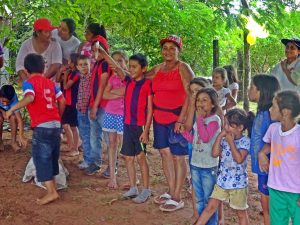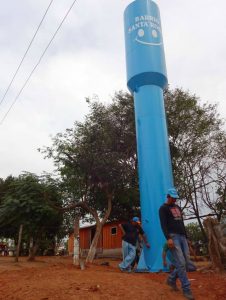This project is made possible through the partnership of WATER CHARITY and the NATIONAL PEACE CORPS ASSOCIATION. ![]()
This project has been completed. To read about the conclusion, CLICK HERE.
 Location
Location
Barrio Santa Rosa’i, San Estanislao, San Pedro, Paraguay
Community Description
Barrio Santa Rosa’i (in San Estanislao, San Pedro, Paraguay) is a small agricultural community in the northern department of Paraguay. Barrio Santa Rosa’i consists of a group of dedicated Paraguayans who live in a relatively new settlement. Unofficial census data reports that 78 families and over 450 people live in the community, with many more children than commute from surrounding communities to attend the school, which offers a program of preschool through ninth grade.
Most families are subsistence farmers, with their primary source of income-based around the production of bananas, mandioca, lettuce, corn, tomatoes, beets, and carrots cultivated for exportation. The community’s small producers and the women’s committee also produce a variety of animal products, baked goods, and artisanal items that they sell locally in nearby Barrio Fatima, surrounding schools, and the city center of San Estanislao. Much of social life revolves around the church, school events, community organizational group meetings, and soccer and bingo games held most Sundays.
Problem Addressed
During the last 10 years, the community of Barrio Santa Rosa’s and the Water Commission of the Barrio de Santa Rosa’i have tried to work with the local municipality to ensure a potable water system for approximately 450 people, including a church, school, and an area for the community. Due to changing political factors and circumstances beyond their control, the water commission has not been successful in its efforts to provide a regulated water system that reaches all families in the community.
 Currently, there is a water tank available within the community, but the recurring dry summers have led to an unreliable water source. The community only has access to water for less than one hour in the morning and less than one hour at night, which means that water is not available for sanitation, drinking, caring for animals, and crop production. In addition, the school (from preschool to ninth grade) within the community lacks reliable water. At this time, the parents of the students bring what little water they can to the school, but the supply is still inadequate. This is important, because unsafe water, inadequate sanitation, and lack of hygiene affect the health, safety, and quality of life of the students.
Currently, there is a water tank available within the community, but the recurring dry summers have led to an unreliable water source. The community only has access to water for less than one hour in the morning and less than one hour at night, which means that water is not available for sanitation, drinking, caring for animals, and crop production. In addition, the school (from preschool to ninth grade) within the community lacks reliable water. At this time, the parents of the students bring what little water they can to the school, but the supply is still inadequate. This is important, because unsafe water, inadequate sanitation, and lack of hygiene affect the health, safety, and quality of life of the students.
Project Description
The project activities include the installation of a well pump and the construction of a water tower and a water tank.
In 2016, an excavation of a new well took place at a depth of 160 meters.
The primary components of the project will be to:
(1) Coordinate with the water commission leaders, the local municipality, and a private company to engineer and equip the well with a motor and transformer.
(2) Erect and connect the 15,000-liter steel water tower to the well system.
(3) Work with community leaders to establish water system management techniques, water hygiene, and quality standards.
Water Charity funding will be allocated to the cost of the 15,000-liter steel water tower, operation stand, perimeter fence, and necessary electrical installation with the private company.
 The community and municipality will be responsible for the electric submersible 3HP 220V – Brand Pedrollo motor, a 25 KVA transformer, and materials associated with installation.
The community and municipality will be responsible for the electric submersible 3HP 220V – Brand Pedrollo motor, a 25 KVA transformer, and materials associated with installation.
The PCV has facilitated workshops on effective leadership and organization, covering topics related to water system management, organizational transparency, and accountability standards. Through these workshops, the commission and community members have had the opportunity to develop and implement a long-term management plan for the water system, resulting in a stronger relationship of respect and trust among the community members that will ensure the longevity of the water system.
Project Impact
450 people will benefit from the project.
Peace Corps Volunteer Directing Project
Daniel Humble, PCV
Monitoring and Maintenance
The PCV will continue to monitor the project through the end of his service, but the focus is placed on the community’s water commission to conduct long-term management of the water system and its continued maintenance.
 The water system installation will be by an engineer from a reputable private company and will provide the community with a 2-year system guarantee and continuous on-call maintenance support.
The water system installation will be by an engineer from a reputable private company and will provide the community with a 2-year system guarantee and continuous on-call maintenance support.
Long-term sustainability is through the following steps:
(1) The establishment of a sustainable long-term water system maintenance plan and payment schedule agreed upon by community members.
(2) Commission leadership participation in and co-facilitation of educational workshops with PCV and community members on the workings of the water system and its long-term management.
(3) Workshops (facilitated through the current PCV) with commission leaders on effective organizational leadership, focusing on the importance of accountability, communication, and transparency.
(4) Collaborative teachings (facilitated by community leadership and current PCV) at the school that focuses on water quality, hygiene, and the prevention of waterborne illness.
Project Funding
The funds to get this project underway have been provided by the Paul Bechtner Foundation.
Conclusion of San Pedro Water Project – Paraguay
This project has been completed under the direction of Peace Corps Volunteer Daniel Humble. To read about the start of the project, CLICK HERE.

The project was designed to install a pump on the 160-meter well and construct a tower and 15,000-liter water tank.
Daniel reports:
The community was able to complete the installation of a well pump and construction of a water tower and a water tank according to plan.
The impact this project will have are many, including the improvement of environmental health, the improved capacity of the participants to define and reach future goals and objectives, improved linkages with the members of the community and networks, and improved decision making by changing attitudes.
We extend our thanks to Danie for completing this important project.





